The Meizu M3 Note vs. Xiaomi Redmi Note 3 Review: Comparing Notes
by Matt Humrick on July 12, 2016 8:00 AM EST- Posted in
- Smartphones
- Mobile
- Xiaomi
- Meizu
- Redmi
Battery Life
Battery life is very difficult to quantify because there are so many variables in play. The different apps people use, which ones are running in the background, what networks the phone is connected to, and the signal strength of those networks are just a few examples of why battery life differs from one person to the next. Our battery life tests mimic a few common workloads while controlling as many of these variables as possible, which includes calibrating each display to 200 nits at 100% APL. They are not meant to tell you how long a phone will last during a typical day for you. Instead, they are designed to fairly compare the runtime potential of one phone to another.
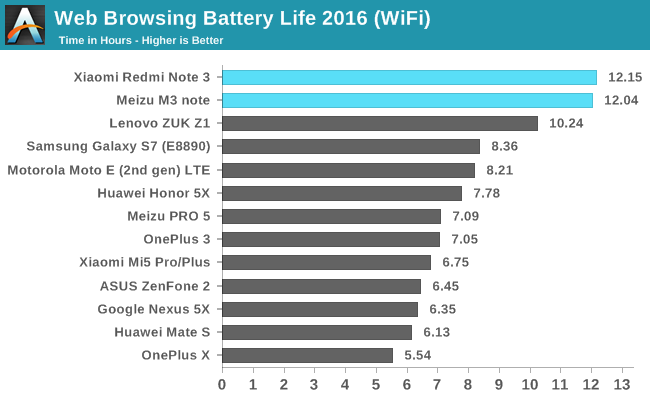
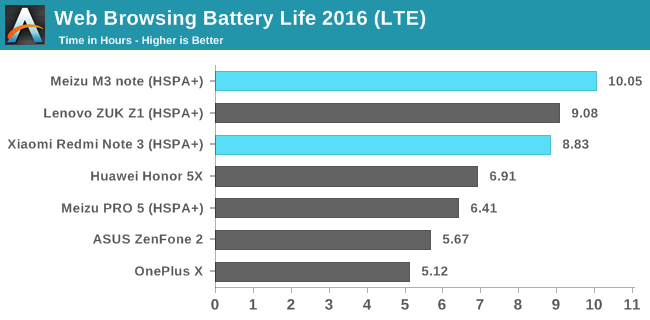
Our new browsing tests are more realistic, making better use of the CPU by pausing and then scrolling through each page. When browsing over Wi-Fi, both the Meizu M3 note and Xiaomi Redmi Note 3 make good use of their larger than 4000mAh batteries to last for an impressive 12 hours, more than 4 hours longer than the Huawei Honor 5X and its 3000mAh battery. A rough calculation gives the Redmi Note 3 an average platform power (APP) of 1.28W, a little less than the Honor 5X at 1.47W and the Mate S at 1.75W.
Several of the devices we’re comparing do not support US LTE frequency bands, so they are using WCDMA/HSPA+ instead, as noted in the above chart. The M3 note lasts the longest here—an impressive 10 hours. Both the ZUK Z1 (which also has a 4100mAh battery like the M3 note) and Redmi Note 3 are not far behind at 9 hours. Comparing APP, the M3 note does better than the Redmi Note 3 when using its cellular radio but the difference is small, with the M3 note, Honor 5X, and Redmi Note 3 falling between 1.6W to 1.8W, in that order.
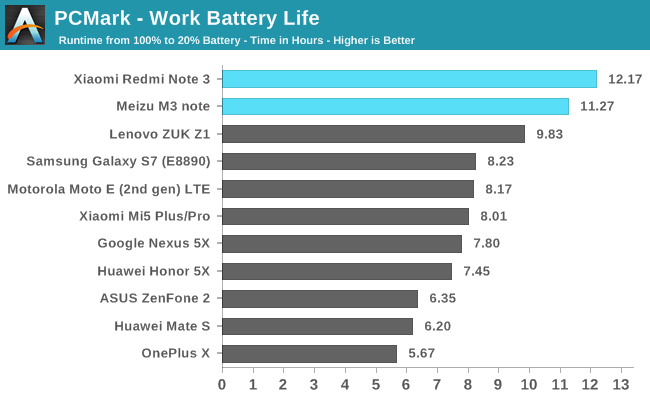
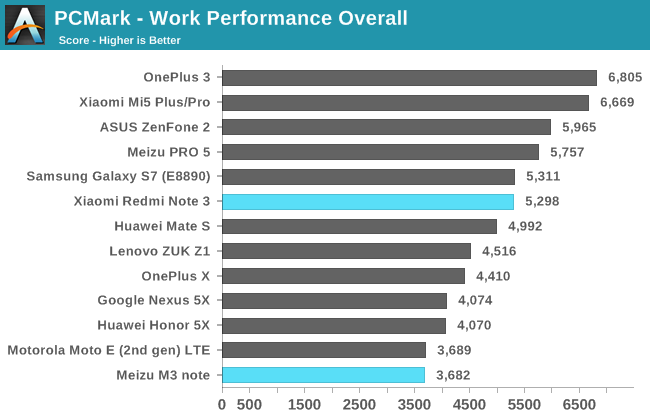
Both the M3 note and Redmi Note 3 last a long time while running PCMark’s realistic workloads, outlasting even the Huawei Mate 8 and ZUK Z1 that both reach 9.83 hours. The Redmi Note 3 stands out, however, because it lasts over 12 hours while still delivering better performance than its peers. For example, it outperforms the Honor 5X by 30% overall and lasts 4.7 hours longer. The Mate S delivers similar performance to the Redmi Note 3, even outperforming the Note in specific tests, but its smaller battery helps cut runtime in almost half relative to the Note. The Redmi Note 3 also matches the average PCMark performance of the Galaxy S7 (Exynos 8890) and still lasts 4 hours longer.
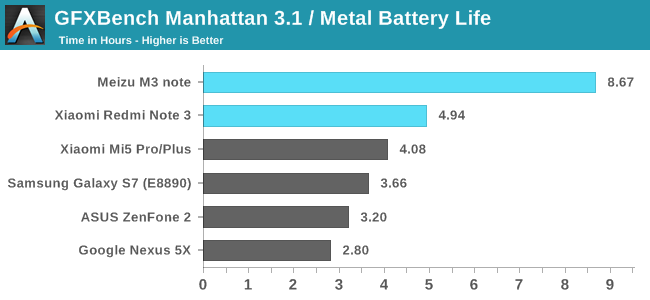
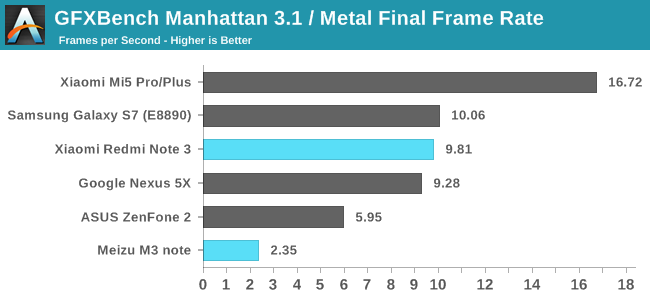
The GFXBench Manhattan 3.1 battery life test stresses the GPU, providing an estimate for both a device’s runtime while playing games and its frame rate stability. As noted in the previous section on GPU performance, not all of the phones we’re comparing in this roundup are capable of running this OpenGL ES 3.1 game simulation, which is why there are so few devices in these charts.
The M3 note lasts more than 8.5 hours, which is the longest for any phone we’ve tested to date. This result is tempered, however, by its rather poor performance. In the previous section, we concluded that the M3 note’s low-power GPU is only suitable for casual gaming after performing poorly in our test suite and failing to deliver playable frame rates in some 3D games. There is some good news, however: If you only play games like “Angry Birds” or “Words With Friends,” you can play them for a very long time.
The Galaxy S7’s (Exynos 8890) peak performance is about 50% higher than the Redmi Note 3’s, but their sustained onscreen performance is essentially the same after heat forces the S7 to throttle back after 20-25 minutes (the S7 renders onscreen at 1440p vs. 1080p for the Redmi Note 3, so the S7 is still doing more work). The Redmi Note 3 is like a long-distance runner, maintaining an even pace and outlasting the initially faster Galaxy S7 (Exynos 8890) by 1.25 hours. While not shown in the chart above, the more-expensive Galaxy S7 edge (Snapdragon 820) and Huawei Mate 8 have bigger batteries than the Galaxy S7, giving them a runtime on par with the Redmi Note 3 at the same sustained performance. Only Xiaomi’s Mi5 Pro (also with a 1080p LCD display) maintains a higher level of performance over the duration of the test while lasting almost as long as the Redmi Note 3.
The GFXBench Manhattan 3.1 performance stability graphs look pleasantly boring. Both the M3 note and Redmi Note 3 avoid thermal throttling, maintaining the same level of onscreen graphics performance until they run out of battery power. The Redmi Note 3 gets warm but not hot, while the M3 note remains cool to the touch.
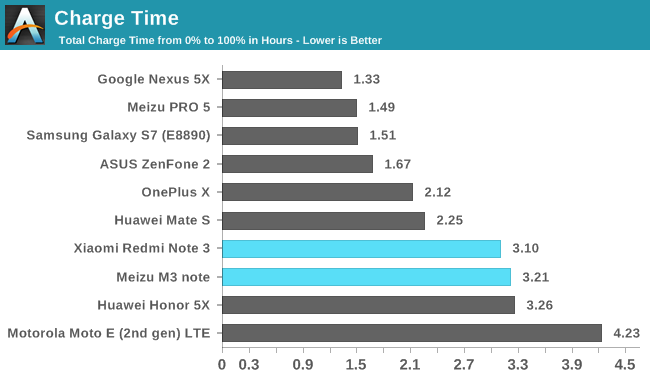
Both phones come with 10W chargers (5V at 2A) that are capable of fully charging their large batteries in just over 3 hours. Despite its 25% smaller battery, the Honor 5X takes just as long to charge, because it comes with only a 5W charger.
The M3 note and Redmi Note 3 have excellent battery life according to our tests. The M3 note lasts just as long or a little longer than the Redmi Note 3, but its SoC does not deliver the same level of performance.
Audio Quality
Smartphone audio quality has been on the rise the past few years. While external speakers still show significant variation in sound quality, headphone output has become consistently good, at least among mid-range and flagship phones. There’s even a few, like the Meizu PRO 5 we previously reviewed, that really sound excellent. Has any of this audio technology found its way into lower-cost devices yet?
The M3 note has a single downward-firing speaker sitting behind the series of holes on the right. It gets reasonably loud, but the volume control is nonlinear, so it needs to be turned up almost all the way before it becomes audible across a room or inside a pocket. The sound is very tinny without much contribution from lower frequencies. It’s difficult to hear softer background instruments when listening to music, with sounds blurring together into a cacophony of noise. The M3 note’s speaker is best suited for basic ringtone duty, and even then you have to turn the volume way up.
The Redmi Note 3’s mono speaker is on the back of the phone. Because its sound is aimed away from your ears, you have to cup your hand behind the phone or place it in front of a hard surface to reflect the sound back towards you. This becomes a problem, however, when the phone is resting on a surface with the screen facing up. The back of the Redmi Note 3 is flat, which means the speaker is nearly flush with the surface underneath. A small bump, which sits just below the speaker, is meant to lift the phone slightly to give the speaker some breathing room; however, it’s not enough. Setting the phone on a wood table muffles the sound and degrades quality. Placing it on a softer surface, such as a leather chair, chokes the sound almost completely.
Giving the Redmi Note 3’s speaker some room to work yields decent results, definitely better than the M3 note. The speaker sounds better with a hand cupped behind the phone, producing a fuller sound without the faint background hiss that’s present when listening to music directly from the speaker. There’s more lower-frequency content than the M3 note, and voices sound distinct and pretty clear. The speaker also gets loud enough to hear in most situations.
The first thing I noticed when plugging a set of headphones into the Redmi Note 3 was that it gets very loud. After resetting the volume to a more sensible level, I found its sound quality to be decent but not quite as good as the iPhone 6s I was using as a reference. Everything was fine until the music got too complex, with many different sounds layered together, at which point I noticed a subtle lack of clarity and a deficit in depth and separation. Diving into the settings menu, I enabled the “Mi Sound Enhancer” and adjusted the EQ, which fixed the initial problems I heard. Based on my subjective results, I’d say the Redmi Note 3’s hardware is pretty close to what’s in the iPhone 6s, but requires some extra effort fiddling with the software to get the most from it.
The M3 note’s headphone amplifier does not have the same output power as the Redmi Note 3 or iPhone 6s reference. It’s capable of driving low-impedance headphones to sufficient volume levels, but is not capable of driving higher-impedance loads. Sound quality is nothing special either, clearly falling below the iPhone 6s and Redmi Note 3. As is typical for a lower-powered amplifier, it sounds a bit dull and lifeless, with limited dynamic range. The sound is not horrible, though; less-critical listeners using a typical set of earbuds will likely find the M3 note’s sound to be good enough. This does show that audio quality remains a point of differentiation at this price point.



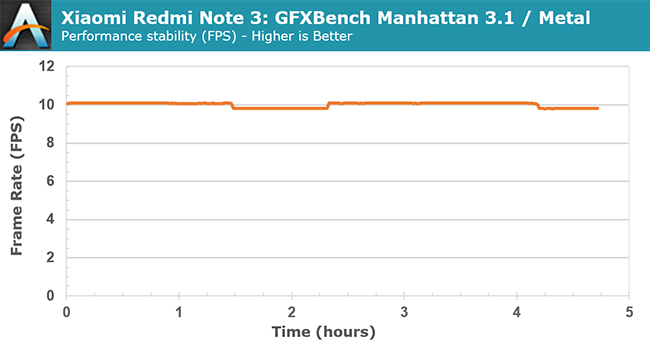
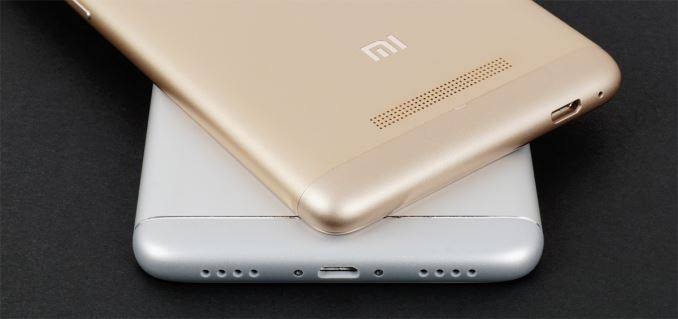








79 Comments
View All Comments
Pissedoffyouth - Wednesday, July 13, 2016 - link
Yes, on my RN3 I see June patch levelImpulses - Thursday, July 14, 2016 - link
Very interesting.Pissedoffyouth - Monday, July 25, 2016 - link
July now and I have August patch level. Very fast.serendip - Wednesday, July 13, 2016 - link
Xiaomi are pretty good at updating the Android patch level for their developer ROMs. Their Chinese-market developer ROMs are updated weekly, whereas global developer ROMs with built-in Google Play get updated once every few months. Stable ROMs come out about once a quarter.You can get the best of both worlds by using custom ROMs from Xiaomi.eu that combine the features and updates of the Chinese-market developer ROM and built-in Google Play, with a lot of Chinese bloatware stripped out. I've been using these for my ancient Redmi Note (the first of the line!) for years without major issues.
One thing Xiaomi really suck at is updating the kernel. A lot of older devices are still stuck on KitKat and without kernel sources, we can't compile a bug-free Marshmallow release. Maybe it's a MediaTek thing not to release sources but whoever it is, they're not doing themselves a favor.
SyukriLajin - Thursday, August 11, 2016 - link
ironically, the very heavily customized MIUI have a waaay better monthly security patches update policy than a lot of those "almost stock android" from other manufacturer.tuxRoller - Tuesday, July 12, 2016 - link
The gpu is the consistent achilles of these chinese soc. If they would just up the gpu core count you'd end up with a far more balanced device.OTOH, the snapdragon looks to be pretty strong. Its gpu is better than I expected.
asfletch - Tuesday, July 12, 2016 - link
Thanks for this review Matt - reviews of Chinese phones usually gloss over the screen quality ("looks fine" etc), so nice to see AT putting them through the wringer.Re Redmi Note 3, the performance is really impressive. Do you know whether the black version still has a ridge around the edge of its glass? It looks like only the gold and white versions are afflicted with that - could just be less visible on the black ones though. Black one also conceals black border around the IPS panel better. I'd have bought one over the Galaxy Note 4 I ended up with if they'd just kept the removable battery of the RN2.
abcdravi - Wednesday, July 13, 2016 - link
Matt, just signed in to say this. This is a really good review!R0H1T - Wednesday, July 13, 2016 - link
@Death666Angel guess that depends on where you live then, in India there is no RN3/Pro with Helio likewise Le2 is also laced with SD652, therefore no Mediatek models here. Having owned the RN3 for just over 4 months, the SD650 one, I can safely say that it's by far the best VFM smartphone out there.Impulses - Wednesday, July 13, 2016 - link
Nicely done review...Also, -in before the HTC10/GTX1080 review whines-... :p